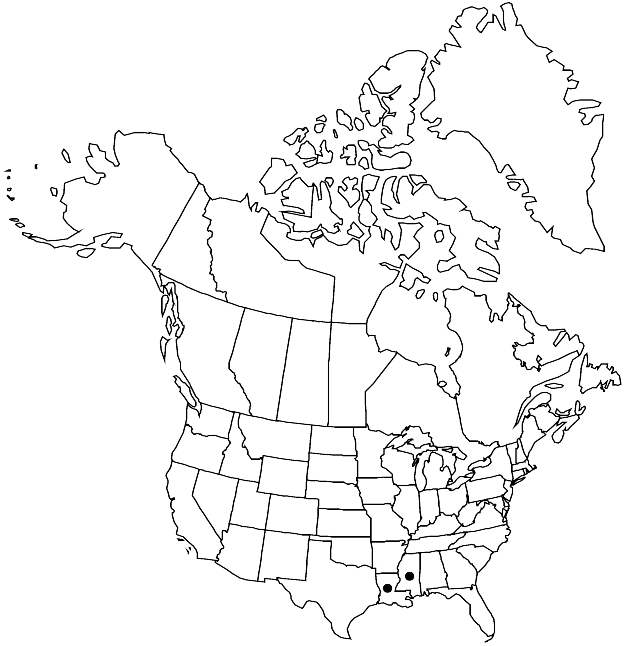Difference between revisions of "Trachyxiphium hypnaceum"
Brittonia 39: 220. 1987.
FNA>Volume Importer |
FNA>Volume Importer |
||
| Line 18: | Line 18: | ||
|name=Hookeriopsis heteroica | |name=Hookeriopsis heteroica | ||
|authority=Cardot | |authority=Cardot | ||
| − | }}{{Treatment/ID/Synonym | + | }} {{Treatment/ID/Synonym |
|name=Trachyxiphium heteroicum | |name=Trachyxiphium heteroicum | ||
|authority=(Cardot) W. R. Buck | |authority=(Cardot) W. R. Buck | ||
| Line 36: | Line 36: | ||
|elevation=moderate elevations | |elevation=moderate elevations | ||
|distribution=La.;Miss.;Mexico (Chiapas;Oaxaca;Puebla;Veracruz);South America;Pacific Islands (Cocos Island). | |distribution=La.;Miss.;Mexico (Chiapas;Oaxaca;Puebla;Veracruz);South America;Pacific Islands (Cocos Island). | ||
| − | |discussion=<p>Trachyxiphium hypnaceum has been reported as abundantly fruiting (W. D. Reese 1974). This species is rare in the flora area, occurring in one parish (Washington) in Louisiana and two counties (Franklin and Washington) in Mississippi (C. Delgadillo M., pers. comm.). Trachyxiphium hypnaceum is easily recognized by its erect-spreading, distally secund leaves, which are lanceolate-acuminate with smooth and narrow cells, and the dorsally strongly serrulate costae. Callicostella pallida is similar in its somewhat thinner but similarly robust double costa and broad leaves lacking a margin of differentiated cells, but C. pallida leaves are lingulate with an abrupt apiculus (not long-acuminate) and have isodiametric laminal cells with a central papilla and firm walls (not linear-rhomboidal and thin-walled). W. D. Reese and B. E. Lemmon (1970) suggested that the isolated occurrence of species of Pilotrichaceae indicates chance introduction. Reese noted that collections of Trachyxiphium were associated with human activity, namely a fabricated lake in Mississippi and concrete culvert in Louisiana.</p> | + | |discussion=<p><i>Trachyxiphium hypnaceum</i> has been reported as abundantly fruiting (W. D. Reese 1974). This species is rare in the flora area, occurring in one parish (Washington) in Louisiana and two counties (Franklin and Washington) in Mississippi (C. Delgadillo M., pers. comm.). <i>Trachyxiphium hypnaceum</i> is easily recognized by its erect-spreading, distally secund leaves, which are lanceolate-acuminate with smooth and narrow cells, and the dorsally strongly serrulate costae. <i>Callicostella pallida</i> is similar in its somewhat thinner but similarly robust double costa and broad leaves lacking a margin of differentiated cells, but <i>C. pallida</i> leaves are lingulate with an abrupt apiculus (not long-acuminate) and have isodiametric laminal cells with a central papilla and firm walls (not linear-rhomboidal and thin-walled). W. D. Reese and B. E. Lemmon (1970) suggested that the isolated occurrence of species of Pilotrichaceae indicates chance introduction. Reese noted that collections of <i>Trachyxiphium</i> were associated with human activity, namely a fabricated lake in Mississippi and concrete culvert in Louisiana.</p> |
|tables= | |tables= | ||
|references= | |references= | ||
| Line 60: | Line 60: | ||
|publication year=1987 | |publication year=1987 | ||
|special status=Selected by author to be illustrated | |special status=Selected by author to be illustrated | ||
| − | |source xml=https://jpend@bitbucket.org/aafc-mbb/fna-data-curation.git/src/ | + | |source xml=https://jpend@bitbucket.org/aafc-mbb/fna-data-curation.git/src/8f726806613d60c220dc4493de13607dd3150896/coarse_grained_fna_xml/V28/V28_407.xml |
|genus=Trachyxiphium | |genus=Trachyxiphium | ||
|species=Trachyxiphium hypnaceum | |species=Trachyxiphium hypnaceum | ||
Revision as of 18:05, 18 September 2019
Stems with cortical cells small, walls somewhat thicker than those of central cells. Leaves loosely erect-spreading, somewhat distant, incurved when dry, lightly to strongly falcate-secund near stem apices, concave in proximal 2/3, not undulate or plicate, 0.9–1.5 mm; marginal teeth single or double, often tipped with 1 papilla; apex gradually or sometimes abruptly narrowing, acumen flat, sharply pointed; costa slender, cristate distally; distal laminal cells linear-rhomboidal, 7.5–10:1, pellucid, walls thin. Seta 0.6–1.2 cm. Capsule black, 0.7–1.5 mm. Calyptra covering distal portion of urn. Spores 8–11 µm, smooth.
Phenology: Capsules mature spring (early Mar).
Habitat: Rock, wet places on soil, tree bases, wet, rotted wood, near spring seepage and stream banks, deep shade in wet forests, concrete culvert around springs, cut-over woods of Fagus, Magnolia grandiflora, Pinus
Elevation: moderate elevations
Distribution

La., Miss., Mexico (Chiapas, Oaxaca, Puebla, Veracruz), South America, Pacific Islands (Cocos Island).
Discussion
Trachyxiphium hypnaceum has been reported as abundantly fruiting (W. D. Reese 1974). This species is rare in the flora area, occurring in one parish (Washington) in Louisiana and two counties (Franklin and Washington) in Mississippi (C. Delgadillo M., pers. comm.). Trachyxiphium hypnaceum is easily recognized by its erect-spreading, distally secund leaves, which are lanceolate-acuminate with smooth and narrow cells, and the dorsally strongly serrulate costae. Callicostella pallida is similar in its somewhat thinner but similarly robust double costa and broad leaves lacking a margin of differentiated cells, but C. pallida leaves are lingulate with an abrupt apiculus (not long-acuminate) and have isodiametric laminal cells with a central papilla and firm walls (not linear-rhomboidal and thin-walled). W. D. Reese and B. E. Lemmon (1970) suggested that the isolated occurrence of species of Pilotrichaceae indicates chance introduction. Reese noted that collections of Trachyxiphium were associated with human activity, namely a fabricated lake in Mississippi and concrete culvert in Louisiana.
Selected References
None.
